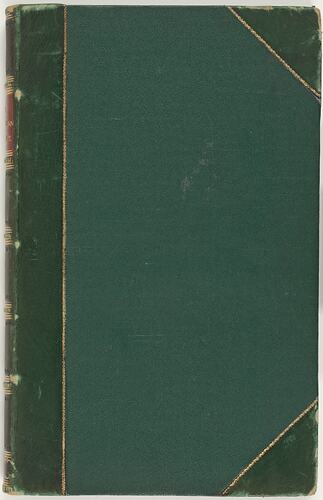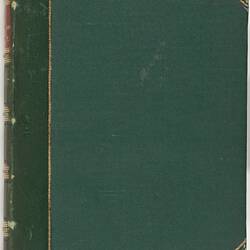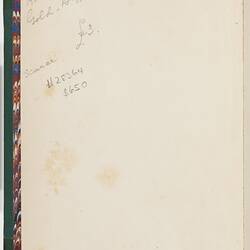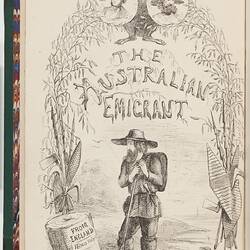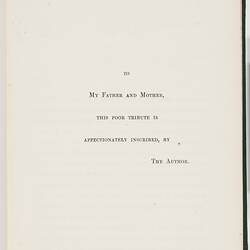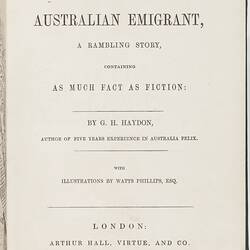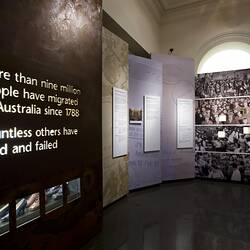Summary
Book entitled 'The Australian Emigrant' by George Henry Haydon, First Edition, 1854. This book was intended as a guide book for potential immigrants. The frontispiece of this book includes a humorous sketch showing the 'before' and 'after' of emigration and the self-reliance of the successful immigrant. The book draws on many of Haydon's experiences from the five years he spent in Victoria from 1840-1845. During his time in Australia Haydon cultivated the image of the colonial frontiersman and espoused the bush virtues of hospitality, mateship and self-reliance, all of which found expression in this novel.
George Henry Haydon was born in Heavitree, Devon, England, on 26 August 1822. Looking for adventure, he migrated to Melbourne in July 1840, where he worked as a clerk in William Kerr's bookshop, as an architect designing terraced cottages and then for the newspapers. He became one of Melbourne's first drawing masters and also sold sketches to the papers. Haydon was concerned about Aboriginal people, whom he defended against the prejudices of the colonists, and studied their language and customs. His friend and shooting companion was Benbo, of the Werribee 'tribe', who once saved his life and was the subject of many sketches.
Haydon sailed in the Abberton for England in January 1845, with a bottle of Yarra water for christening purposes and a kangaroo rat which died on the ship. On his return to England he set himself up as an authority on emigration and gave many lectures. He married Clarissa Risdon on 20 December 1851; they had four sons and one daughter. In 1849 Haydon was appointed steward of the Devon County 'Lunatic Asylum' at Exminster, was steward of Bridewell and Bethlem hospitals, London from 1853-89, and in 1865 he was called to the Bar at the Middle Temple. Haydon died at his home, Ettrick, Putney Lower Common, on 9 November 1891.
The term 'lunatic asylum' was in official use in Victoria until 1903.
Physical Description
Green covered hardcover book of 192 pages. Gold painted along spine and at edges. The book contains six wood engraved plates. The frontispiece of the book includes a humorous sketch by the author,
More Information
-
Collecting Areas
-
Acquisition Information
Purchase
-
Author
-
Place & Date Depicted
-
Inscriptions
On spine: THE/AUSTRALIAN/EMIGRANT.
-
Classification
-
Category
-
Discipline
-
Type of item
-
Object Measurements
13.9 cm (Width), 19 cm (Depth), 21.6 cm (Height)
Measurement of closed book.
-
Keywords
British Immigration, Gold Rushes, Immigrant Shipping, Immigrant Voyages, Immigration, Migration & Settlement, Guide Books
